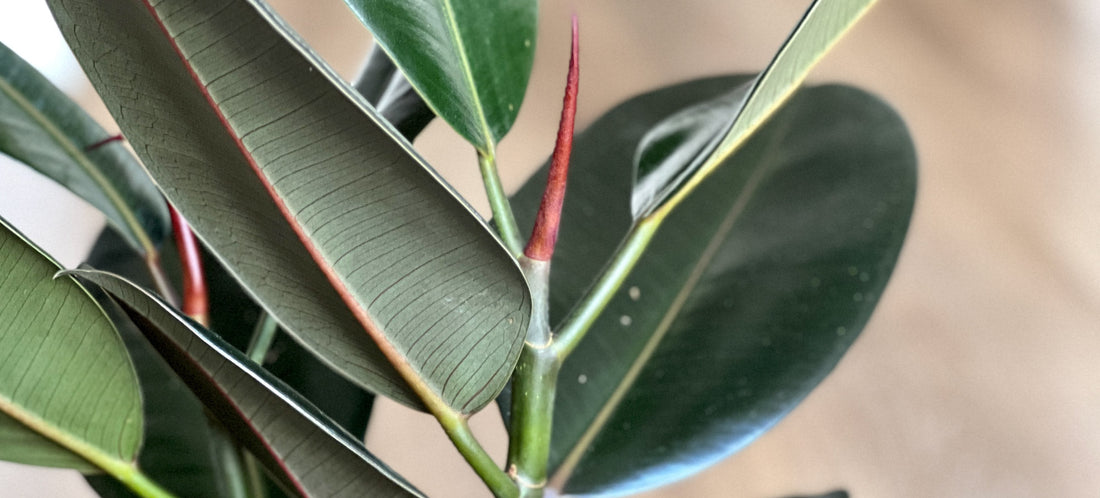
If you're searching for a houseplant that's low maintenance but high impact, look no further than the rubber plant (Ficus elastica). This bold beauty is famous for its glossy, oversized leaves and sculptural form, making it a standout choice for any indoor space. Whether you're a seasoned plant parent or just getting started, rubber tree care is surprisingly simple once you know the basics.
In this guide, we'll cover rubber plant care, how to choose the right variety (including the stunning variegated rubber plant), how to propagate a rubber plant, and the best way to nourish your plant with the right rubber plant fertilizer.

Why You'll Love the Rubber Plant (Ficus Elastica)
The indoor rubber plant is beloved for its:
- Striking appearance: Large, glossy leaves in deep green, burgundy, or variegated patterns.
- Low maintenance needs: Thrives in typical indoor conditions with minimal fuss.
- Air-purifying power: Helps filter indoor air, creating a healthier environment.
With the right care, your rubber tree will grow into a breathtaking statement piece in your home.

Rubber Plant Care Basics
- Light: Prefers bright, indirect light. Variegated rubber plants need a bit more brightness to maintain their color.
- Water: Let the top half of soil dry out before watering again. Overwatering is the most common mistake.
- Humidity: Average indoor humidity is fine, but higher humidity helps keep leaves supple and vibrant.
- Soil: Use a well-draining potting mix, and consider blending in perlite or orchid bark for improved aeration. Resist the temptation to add pebbles at the bottom of the pot — it doesn't help with drainage and can actually cause water to accumulate above the rocks, creating a "perched water table" that increases the risk of root rot.
- Fertilizer: During the growing season, feed monthly with a high-quality rubber plant fertilizer like Fiddle Leaf Treats® to support lush growth and vibrant color.
-
Leaf care: Like all big leaf houseplants, your rubber tree benefits from regular, gentle
leaf care. Wipe the leaves with a soft, microfiber gloves to remove dust, which can block sunlight and reduce photosynthesis. While you're at it, take a moment to give a spritz of Big Leaf Energy® and inspect for common pests like spider mites or scale, catching any issues early before they spread.
Pro Tip: Choose a urea-free formula like Fiddle Leaf Treats® for optimal nutrient absorption without salt buildup.
How to Propagate a Rubber Plant
Growing your own new plants is easy once you learn how to propagate a rubber plant:
- Choose a healthy stem with at least one leaf and a node.
- Cut just below the node using clean, sharp scissors.
- Allow the stem to heal over for a day.
- Place the cutting in a solution of water and fertilizer.
- Pro tip: Add an air stone for good oxygenation
- Keep in a bright, warm spot out of direct sun.
- Roots typically form within 4–6 weeks.
Propagation works best in the spring and summer when the plant is actively growing.
Meet the Variegated Rubber Plant
The variegated rubber plant—like Ficus elastica 'Tineke' and 'Ruby'—features gorgeous streaks of cream, green, and even pink. These varieties need slightly more light to maintain their vibrant colors but are just as easy to care for as traditional green types.
If you want to elevate your plant collection with a splash of color, the variegated rubber plant is a must-have.

Common Rubber Plant Problems (and How to Fix Them)
- Yellowing Leaves: Often caused by overwatering, but can also be nutrient deficiency. Let the soil dry more between waterings.
- Leaf Drop: This can have a number of causes. Dry soil is common, moving the plant or exposure to cold drafts is another issue. Keep it in a stable environment.
- Brown Leaf Edges: Typically a sign of low humidity, dryness, or inconsistent watering.
- Brown Leaf Centers: This is an indication of disease typically caused by watering too often, check for root rot. Remediate if needed.
- Stunted Growth: Could mean the plant needs more light or a dose of ficus plant food.
Address these issues quickly to keep your indoor rubber plant thriving!
How Fast Do Rubber Plants Grow?
With proper care, a rubber plant can grow 1–2 feet per year indoors. Given the right conditions, it can reach heights of up to 6–10 feet inside your home over time!
Outdoors in tropical climates, they can grow into towering trees, but indoors they stay much more manageable and stylish.
Best Planters and Soil for Rubber Plants
- Planters: Choose deep, sturdy pots with drainage holes. Rubber plants can become top-heavy as they grow.
- Soil Mix: A well-draining mix is key. Blend a homemade potting soil with perlite and sterile materials for good aeration, pest and disease control, and stability.
Fun Facts About Rubber Plants
- Rubber plants were historically used to produce natural rubber before latex trees became the standard.
- They're considered lucky plants in Feng Shui, symbolizing wealth and abundance.
- In the wild, rubber trees can grow aerial roots that eventually anchor into the ground and support massive canopies!
Frequently Asked Questions About Rubber Plants
What is a rubber plant?
A rubber plant (Ficus elastica) is a popular indoor houseplant known for its large, glossy leaves and minimal care requirements. It makes a bold statement in any home with its tree-like structure and deep green or variegated foliage.
Note: The "baby rubber plant" (Peperomia obtusifolia) is not actually related to the true rubber plant (Ficus elastica). Despite the similar nickname and thick, glossy leaves, baby rubber plants belong to a completely different plant family and have slightly different care needs.
How do you care for a rubber plant?
To care for a rubber plant, provide bright, indirect light, allow the soil to dry slightly between waterings, maintain moderate humidity, and fertilize monthly during the growing season with a high-quality product like Fiddle Leaf Treats®.
How do you propagate a rubber plant?
Rubber plants are easy to propagate. Simply cut a healthy stem just below a node, allow it to heal over for a day, then place the stem in a solution of water and plant food. Pro tip: keep a small air stone in the propagation jar to improve oxygen flow, and keep it in a warm, bright location. Roots should develop within 4–6 weeks.
What is a variegated rubber plant?
A variegated rubber plant, such as Ficus elastica 'Tineke' or 'Ruby', features stunning patterns of cream, green, and pink. These varieties need very bright, indirect light to maintain their colorful variegation.
What are common rubber plant problems?
Common issues with rubber plants include yellowing leaves from overwatering, leaf drop due to drafts or sudden moves, brown leaf edges caused by low humidity, and slow growth from lack of light or nutrients.
How fast do rubber plants grow indoors?
Rubber plants typically grow about 1–2 feet per year indoors. With proper care and fertilizer, they can eventually reach impressive heights of up to 6–10 feet inside your home.

Final Thoughts
With their striking looks and easy care routine, rubber plants are a perfect choice for anyone looking to create a lush, stylish indoor space. Follow these simple rubber plant care tips, feed regularly with a specialty ficus plant food, Fiddle Leaf Treats®, and you'll enjoy years of healthy, vibrant growth from your ficus elastica.
Ready to add one to your collection? Whether it's a classic green or a stunning variegated rubber plant, there's a perfect indoor rubber plant waiting to become the star of your home!



